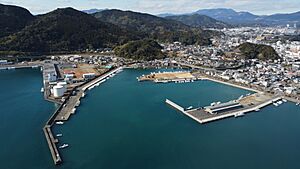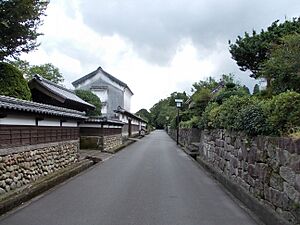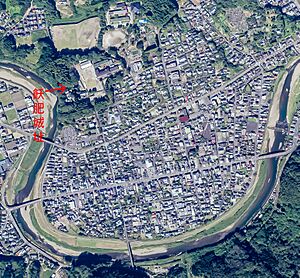Nichinan, Miyazaki facts for kids
Quick facts for kids
Nichinan
日南市
|
|||||||||||||
|---|---|---|---|---|---|---|---|---|---|---|---|---|---|
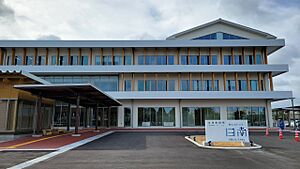
Nichinan City Hall
|
|||||||||||||
|
|||||||||||||
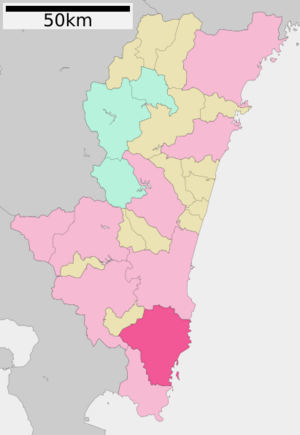 |
|||||||||||||
| Country | Japan | ||||||||||||
| Region | Kyushu | ||||||||||||
| Prefecture | Miyazaki | ||||||||||||
| Area | |||||||||||||
| • Total | 536.11 km2 (206.99 sq mi) | ||||||||||||
| Population
(March 31, 2023)
|
|||||||||||||
| • Total | 47,827 | ||||||||||||
| • Density | 89.2112/km2 (231.056/sq mi) | ||||||||||||
| Time zone | UTC+09:00 (JST) | ||||||||||||
| City hall address | 1-1-1 Chūō-dōri, Nichinan-shi, Miyazaki-ken 887-8585 | ||||||||||||
| Climate | Cfa | ||||||||||||
|
|||||||||||||
Nichinan (日南市, Nichinan-shi) is a city located in Miyazaki Prefecture, Japan. As of May 1, 2023, the city had about 47,872 people living in 21,482 homes. The city covers a total area of 536.11 km2 (206.99 sq mi).
Contents
Geography and Nature
Nichinan is in the southern part of Miyazaki Prefecture, on Kyūshū, which is Japan's southernmost main island. Mountains called the Wanizuka range surround the city on the north, east, and south. To the east, Nichinan faces the Hyūga Sea.
A large part of the city is inside the Nichinan Kaigan Quasi-National Park. This park helps protect the beautiful coastal areas. About 78% of Nichinan is covered by forests. Many of these forests have a special tree called the Obi cedar. The Sakatanigawa River flows through the city from east to west. It joins the Hiroto River and then flows into the Pacific Ocean.
Climate
Nichinan has a humid subtropical climate. This means it has hot, humid summers and cool winters. The average temperature in Nichinan each year is about 18.4 °C (65.1 °F). The city gets a lot of rain, about 2,763.8 mm (108.81 in) per year. June is usually the wettest month.
The warmest month is August, with an average temperature of about 27.8 °C (82.0 °F). The coldest month is January, with an average of about 8.9 °C (48.0 °F). The highest temperature ever recorded in Nichinan was 38.1 °C (100.6 °F) on August 2, 2013. The lowest was −5.1 °C (22.8 °F) on January 24, 1976.
| Climate data for Port Aburatsu, Nichinan (1991−2020 normals, extremes 1949−present) | |||||||||||||
|---|---|---|---|---|---|---|---|---|---|---|---|---|---|
| Month | Jan | Feb | Mar | Apr | May | Jun | Jul | Aug | Sep | Oct | Nov | Dec | Year |
| Record high °C (°F) | 26.3 (79.3) |
24.7 (76.5) |
27.5 (81.5) |
30.0 (86.0) |
33.0 (91.4) |
34.5 (94.1) |
37.5 (99.5) |
38.1 (100.6) |
36.2 (97.2) |
32.5 (90.5) |
29.9 (85.8) |
24.1 (75.4) |
38.1 (100.6) |
| Mean daily maximum °C (°F) | 13.6 (56.5) |
14.6 (58.3) |
17.3 (63.1) |
21.2 (70.2) |
24.6 (76.3) |
26.6 (79.9) |
30.8 (87.4) |
31.5 (88.7) |
28.9 (84.0) |
24.9 (76.8) |
20.4 (68.7) |
15.7 (60.3) |
22.5 (72.5) |
| Daily mean °C (°F) | 8.9 (48.0) |
10.0 (50.0) |
12.9 (55.2) |
16.9 (62.4) |
20.6 (69.1) |
23.4 (74.1) |
27.2 (81.0) |
27.8 (82.0) |
25.3 (77.5) |
20.9 (69.6) |
15.9 (60.6) |
10.9 (51.6) |
18.4 (65.1) |
| Mean daily minimum °C (°F) | 4.6 (40.3) |
5.6 (42.1) |
8.5 (47.3) |
12.6 (54.7) |
16.8 (62.2) |
20.6 (69.1) |
24.4 (75.9) |
24.9 (76.8) |
22.3 (72.1) |
17.4 (63.3) |
12.0 (53.6) |
6.6 (43.9) |
14.7 (58.4) |
| Record low °C (°F) | −5.1 (22.8) |
−4.6 (23.7) |
−2.7 (27.1) |
0.1 (32.2) |
7.4 (45.3) |
12.5 (54.5) |
16.7 (62.1) |
17.5 (63.5) |
11.6 (52.9) |
4.4 (39.9) |
−0.7 (30.7) |
−4.8 (23.4) |
−5.1 (22.8) |
| Average precipitation mm (inches) | 83.9 (3.30) |
132.5 (5.22) |
193.2 (7.61) |
236.7 (9.32) |
247.6 (9.75) |
564.7 (22.23) |
310.4 (12.22) |
230.8 (9.09) |
307.1 (12.09) |
227.8 (8.97) |
137.0 (5.39) |
92.1 (3.63) |
2,763.8 (108.81) |
| Average precipitation days (≥ 1.0 mm) | 6.4 | 7.7 | 11.3 | 10.7 | 10.6 | 16.6 | 11.4 | 12.4 | 12.4 | 8.8 | 7.8 | 5.6 | 121.7 |
| Average relative humidity (%) | 63 | 65 | 67 | 70 | 74 | 82 | 80 | 80 | 78 | 73 | 71 | 66 | 72 |
| Mean monthly sunshine hours | 169.3 | 151.5 | 161.1 | 166.7 | 167.3 | 109.3 | 188.8 | 202.4 | 154.9 | 161.0 | 154.0 | 165.1 | 1,951.4 |
| Source: Japan Meteorological Agency | |||||||||||||
Population Trends
Based on Japanese census data, Nichinan's population in 2020 was 50,848 people. Nichinan has been counting its population since 1920. The numbers show how the population has changed over many years.
| Historical population | ||||||||||||||||||||||||||||||||||||||||||||||||||||||||||||||||||||||
|---|---|---|---|---|---|---|---|---|---|---|---|---|---|---|---|---|---|---|---|---|---|---|---|---|---|---|---|---|---|---|---|---|---|---|---|---|---|---|---|---|---|---|---|---|---|---|---|---|---|---|---|---|---|---|---|---|---|---|---|---|---|---|---|---|---|---|---|---|---|---|
|
|
|||||||||||||||||||||||||||||||||||||||||||||||||||||||||||||||||||||
| Nichinan population statistics | ||||||||||||||||||||||||||||||||||||||||||||||||||||||||||||||||||||||
History of Nichinan
The area where Nichinan is now was once part of an old Japanese region called Hyūga Province. During the Sengoku period (a time of many wars in Japan), the Itō clan ruled this area from Obi Castle. They often fought with the powerful Shimazu clan. The Shimazu clan eventually won in 1578.
Later, a powerful leader named Toyotomi Hideyoshi helped the Itō family get their lands back in 1587. During the Edo period, the Itō clan became daimyō (feudal lords) of the Obi Domain. The borders of this domain were very similar to Nichinan's city limits today. The Obi Domain was known for its excellent school. A famous diplomat named Marquis Komura Jutarō studied there.
Modern City Development
On May 1, 1889, several smaller towns and villages were created. These included Aburatsu, Agata, Obi, Hosoda, Nangō, and Tōgō. Over time, some of these villages grew into towns.
On January 1, 1950, the city of Nichinan was officially formed. It was created by combining the towns of Agata, Aburatsu, and Obi, along with the village of Tōgō. More towns and villages joined Nichinan in the years that followed, making the city larger.
Since 1963, Nichinan has been the spring training location for the Hiroshima Carp baseball team. This means the team comes here to practice before their season starts.
In 1999, a new 12-meter wharf was built at Aburatsu port. This made the port more important for trade. It became a regular stop for both Japanese and international ships. From 2001 to 2010, Nichinan created a plan for its future. The goal was to be "a city that combines its fragrant history and culture with the sunshine and lush green mountains."
In 2009, Nichinan merged with two other towns, Kitagō and Nangō. This made the city even bigger. On August 8, 2024, a strong earthquake happened off the coast of Miyazaki Prefecture. Nichinan felt the earthquake strongly, but thankfully, it was safe.
Economy and Local Products
The main parts of Nichinan's economy are farming, forestry (managing forests), and fishing. Commercial fishing for bonito (a type of fish) is very important here. In 2021, bonito fishing was even recognized as a special Japanese agricultural heritage. Katsuomeshi, a local dish made with bonito sashimi and soy sauce, is very famous.
Farmers in Nichinan grow many different crops. These include mandarin oranges, ponkan (another type of citrus), sweet peas, green peppers, kumquats, and rice.
Education
Nichinan has many schools for children and teenagers. There are 14 public elementary schools and seven public junior high schools. Some schools combine elementary and middle school levels. The Miyazaki Prefectural Board of Education runs two public high schools. There is also one private junior high school and one private high school. For students with special needs, the prefecture also operates one special education school.
Transportation
Railways
You can travel by train in Nichinan using the JR Kyushu Nichinan Line.
- Ibii - Kitagō - Uchinoda - Obi - Nichinan - Aburatsu - Ōdōtsu - Nangō - Taninokuchi - Yowara
Highways
Major roads connect Nichinan to other areas:
 Higashikyushu Expressway
Higashikyushu Expressway National Route 220
National Route 220 National Route 222
National Route 222 National Route 448
National Route 448
Sister Cities
Nichinan has special friendships with other cities around the world. These are called "sister cities" or "twin towns."
 Naha, Okinawa Prefecture, Japan (since 1969)
Naha, Okinawa Prefecture, Japan (since 1969) Portsmouth, New Hampshire, United States (since 1985)
Portsmouth, New Hampshire, United States (since 1985) Inuyama, Aichi Prefecture, Japan (since 2000)
Inuyama, Aichi Prefecture, Japan (since 2000) Albany, Western Australia, Australia (since 2010)
Albany, Western Australia, Australia (since 2010)
Local Attractions and Fun Things to Do
Festivals and Events
Nichinan has three main festivals each year:
- Chikkō-en Sakura Festival (竹香園桜まつり): This festival happens in late March or early April. It's when about 1,000 cherry trees at Chikkō-en park bloom.
- Aburatsu Port Festival (油津港まつり): Held usually on the third weekend of July at Aburatsu port. You can watch Japanese rowing and shihanmato (bow and arrow) competitions. There are also street food stalls, fireworks, and tours of a Maritime Self-Defense Force ship.
- Obi Castle Festival (飫肥城下まつり): This festival takes place on the third weekend of October in the old Obi Town. It's like stepping back into the Edo period! You can see a parade of warriors, the traditional Nichinan Taihei dance, and princesses.
Other fun events include spring and autumn training for the Hiroshima Carp baseball team, swimming and marathon races, and monthly morning markets at Aburatsu port and in front of Nichinan City Hall.
Temples and Shrines
- Udo Shrine (鵜戸神宮, Udo jingū): This unique shrine is built inside a cave on a cliff by the coast. People believe the main god of this shrine is the father of Japan's first emperor, Emperor Jinmu. Visitors often pray here for good luck in finding a partner and for safe childbirth. Below the cliff, there's a large rock shaped like a turtle. It's said that if you can throw a stone into a small dip in the center of the rock, your wishes will come true!
Points of Interest
- Obi Castle (飫肥城, Obi-jō): The main gate of this castle was rebuilt in 1978 using 100-year-old Obi cedar wood. Inside the castle area, you can still see samurai homes, storehouses, and old merchant buildings with white walls. The castle town was very rich in the past. Because it has so many historic buildings, it's sometimes called the "Little Kyoto" of Kyūshū. The Obi castle town is protected as an Important Preservation District for Groups of Traditional Buildings in Japan.
- Matsuo no Maru (松尾の丸): This is a copy of the original palace, also rebuilt using old Obi cedar wood.
- Horikawa Canal District (堀河運河周辺, Horikawa unga shūhen): This is a restored canal area in Aburatsu. It's famous because a Japanese movie, Otoko wa tsurai yo, was filmed here. The canal is 900 meters long and was built way back in 1685. Its main purpose was to float Obi cedar logs safely down to the port from the forests.
- Tsu no mine (津の峯): This is a mountain that overlooks Aburatsu port. Locals call it the "watchtower mountain." During World War II, it was used as a lookout for air raids. Long ago, ships used this mountain to help them navigate into Aburatsu Port.
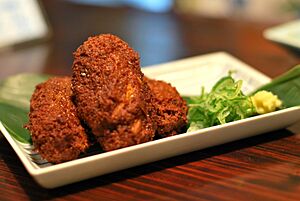
Other interesting places to visit include:
- Merchant House Museum (商家資料館, shōka shiryōkan): Learn about old merchant life.
- Shintoku Domain School (藩校 振徳堂, hankō shintoku-dō): The historic school where famous people studied.
- International Exchange Center and Komura Memorial Hall (国際交流センター小村記念館, kokusai kōryū sentā komura kinenkan): A place for international visitors and a memorial to Komura Jutarō.
- Former Home of Itō Denzaemon (旧伊東伝左衛門家, kyū-Itō Denzaemon-ke): An old traditional Japanese house.
- Horikawa Bridge (堀河橋, Horikawa-bashi): A historic bridge over the canal.
- Horikawa Museum (堀河資料館, Horikawa shiryōkan): Learn more about the Horikawa Canal.
- Red Brick Hall (赤レンガ館, Aka renga kan): A building with unique red brick architecture.
- Izakibana Park (猪崎鼻公園, Izakibana kōen): A park with great views.
- Sun Messe Nichinan (サンメッセ日南): A unique park with Moai statues.
See also
 In Spanish: Nichinan (Miyazaki) para niños
In Spanish: Nichinan (Miyazaki) para niños





